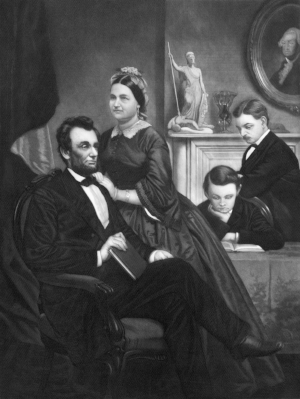BIOGRAPHY of Mary todd Lincoln
Born into a wealthy, political family on December 13, 1818, Mary Todd Lincoln was sophisticated, educated, and versed in politics. On the surface, her success in the White House seemed assured. Yet, few women in American history have endured as much tragedy and controversy.
Mary was the daughter of a prominent Lexington native Robert Smith Todd and his first wife Eliza Parker, who died when Mary was six years old. Mary was the fourth of the eventual sixteen children born in her father’s two marriages. A businessman and politician, Robert provided his children with social standing, education, and material advantages that Mary's future husband, Abraham Lincoln, lacked in his own youth.
Lexington, known as the “Athens of the West” at the time, had numerous educational opportunities for affluent citizens, and Mary completed her extensive education under the tutelage of French immigrant Charlotte Mentelle. At the Todd's large home, maintained by enslaved men and women, Mary mingled with influential political guests. The most prominent of these was three-time presidential candidate Senator Henry Clay, who lived less than two miles away.
A mutual interest in politics was one of the things that drew Mary to attorney Abraham Lincoln, whom she met while visiting an older sister in Springfield, Illinois. Mary exchanged her life of relative ease and privilege for that of a middle-class wife when she married Lincoln in 1842.
Mary’s primary roles from 1842-1860 were wife, household manager, and mother to four sons. Additionally, she actively supported Abraham Lincoln’s political career, offering advice and hosting events. When Lincoln learned that he had had won the presidential election of 1860, he reportedly ran home yelling "Mary, Mary, we are elected."
She took on the role of first lady-from hosting balls to visiting troops-with enthusiasm. However, controversy and tragedy marked Mary Todd Lincoln’s life in the White House. Some mistakenly viewed her as a rustic from the “West." Others questioned her loyalties because of her family connections. While six Todd siblings supported the Union, eight Todd siblings supported the Confederacy through marriage or military service. Not surprisingly, divided loyalties in the Todd family fueled much controversy in the nation’s press.
The White House years were difficult for Mary Lincoln. The pressures and anxieties of the Civil War were unrelenting. Mary watched her husband age under the strain. In early 1862, when their eleven-year-old son Willie died from typhoid fever, Mary was grief-stricken. He was the second of three Lincoln children who would die before adulthood. The heaviest blow fell on April 14, 1865, with Abraham Lincoln’s assassination.
Mary survived her husband by seventeen years. During these years, she traveled internationally, fought for a widow’s pension, explored the practice of spiritualism, and continued to raise her youngest son Tad. Sadly, Tad died shortly after his eighteenth birthday in 1871. Four years later, at the instigation of her only surviving child Robert, Mary was confined against her will for several months at an asylum in Batavia, Illinois. Mary Lincoln’s mental health continues to be debated by historians and is frequently the subject of pop culture references to the former first lady.
Mary Lincoln lived independently in Europe for several years following her controversial institutionalization. Illness forced her to return to the United States, where she died July 1882 in the home of her sister Elizabeth, in which she married Lincoln almost forty years before. Her remains are entombed, along with her husband’s, in Oak Ridge Cemetery in Springfield, Illinois.
Learn more:



